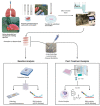Use of Precision-Cut Tissue Slices as a Translational Model to Study Host-Pathogen Interaction
- PMID: 34150901
- PMCID: PMC8212980
- DOI: 10.3389/fvets.2021.686088
Use of Precision-Cut Tissue Slices as a Translational Model to Study Host-Pathogen Interaction
Abstract
The recent increase in new technologies to analyze host-pathogen interaction has fostered a race to develop new methodologies to assess these not only on the cellular level, but also on the tissue level. Due to mouse-other mammal differences, there is a desperate need to develop relevant tissue models that can more closely recapitulate the host tissue during disease and repair. Whereas organoids and organs-on-a-chip technologies have their benefits, they still cannot provide the cellular and structural complexity of the host tissue. Here, precision cut tissue slices (PCTS) may provide invaluable models for complex ex-vivo generated tissues to assess host-pathogen interaction as well as potential vaccine responses in a "whole organ" manner. In this mini review, we discuss the current literature regarding PCTS in veterinary species and advocate that PCTS represent remarkable tools to further close the gap between target identification, subsequent translation of results into clinical studies, and thus opening avenues for future precision medicine approaches.
Keywords: host-pathogen interaction; immunology and infectious diseases; precision cut tissue slices; vaccinology; veterinary.
Copyright © 2021 Majorova, Atkins, Martineau, Vokral, Oosterhuis, Olinga, Wren, Cuccui and Werling.
Conflict of interest statement
The authors declare that the research was conducted in the absence of any commercial or financial relationships that could be construed as a potential conflict of interest.
Figures
References
-
- Ebsen M, Mogilevski G, Anhenn O, Maiworm V, Theegarten D, Schwarze J, et al. . Infection of murine precision cut lung slices (PCLS) with respiratory syncytial virus (RSV) and chlamydophila pneumoniae using the Krumdieck technique. Pathol Res Pract. (2002) 198:747–53. 10.1078/0344-0338-00331 - DOI - PubMed
Publication types
Grants and funding
LinkOut - more resources
Full Text Sources
Miscellaneous


